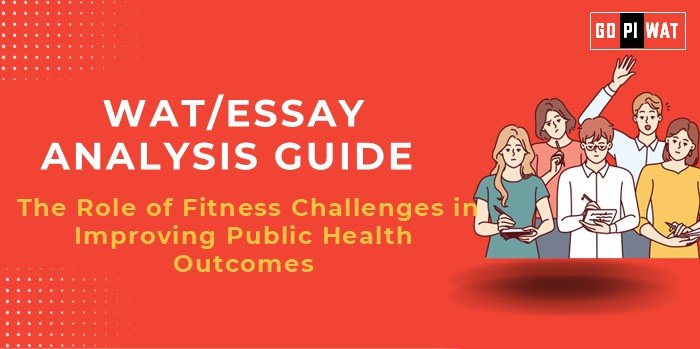📋 WAT/Essay Analysis Guide: The Role of Fitness Challenges in Improving Public Health Outcomes
🌍 Understanding the Topic’s Importance
Fitness challenges represent a strategic intervention to counter lifestyle-related health issues like obesity, diabetes, and heart disease. For B-school students, understanding this topic links to strategic marketing, behavioral change theories, and public health management.
📑 Effective Planning and Writing
- 🕒 Time Allocation:
- ⏱️ Planning: 5 minutes.
- ✍️ Writing: 20 minutes.
- 🔍 Review: 5 minutes.
- 📝 Preparation Tips:
- 📊 Note down relevant statistics like global obesity rates or successful campaigns.
- 👥 Focus on stakeholders, achievements, and challenges.
🎯 Introduction Techniques
- ✨ Contrast Approach: “While fitness challenges inspire millions, their impact on sustainable health improvements remains a question.”
- 💡 Solution-Based Approach: “Fitness challenges could be the key to addressing rising health concerns globally if paired with long-term engagement strategies.”
📖 Structuring the Essay Body
- 🌟 Achievements: Highlight global initiatives like “Couch to 5K” and their impact.
- ⚖️ Challenges with Comparative Analysis: Discuss the sustainability issue, comparing successful programs in the UK and Japan.
- 🚀 Future Outlook: Suggest partnerships between corporations and governments for greater inclusivity.
✍️ Concluding Effectively
- ⚖️ Balanced Conclusion: “Fitness challenges are a step forward, but addressing inclusivity and engagement will ensure their long-term success.”
📝 Sample Short Essays
1. Balanced Perspective
“Fitness challenges have revolutionized public health by driving participation and awareness. However, to make a meaningful difference, they must overcome barriers like accessibility and sustainability.”
2. Solution-Oriented
“Combining fitness challenges with policy initiatives and digital tools could transform public health outcomes for the better.”
3. Global Comparison
“From Japan’s ‘Radio Taiso’ to the UK’s ‘Couch to 5K,’ fitness challenges globally highlight both successes and learnings for sustainable health improvements.”


